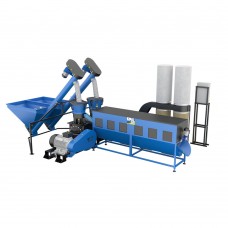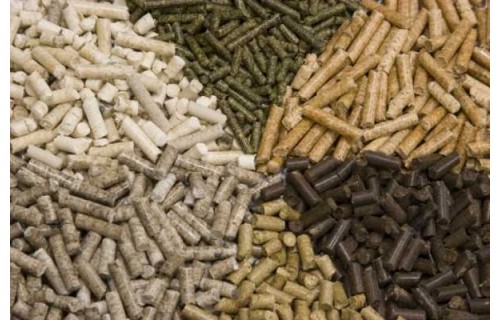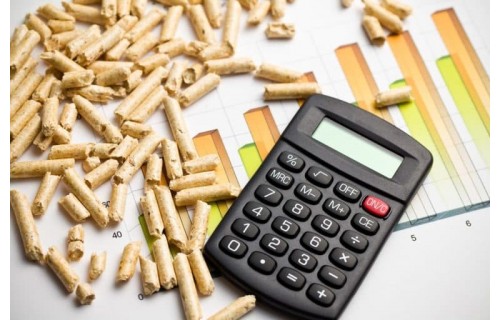Everything you need to know about pelletizers - operation and use

Pellet is a heating material that in recent years has rocketed to a leading position among environmentally friendly fuel materials. Its growing popularity is due to both economic and environmental factors. Compared to fossil fuels such as coal or fuel gas, pellets are a more balanced fuel material with low environmental impact, both at the level of production and combustion.
In an era of continued turbulence in fossil fuel markets, pellets, which are simple to produce and easy to transport, can also prove to be a guarantee of energy stability, especially for farms producing their own biofuel. The simplicity of the pellet production process is also one of its undeniable advantages.
After all, the tool needed to make pellets is only one simple machine, with the help of which wood chips, shavings, sawdust and other waste of natural origin can be turned into energy pellets.
This is a pellet machine (or pelletizer, if you prefer). Let's take a closer look at it.
What is a pelletizer? - The basics
Pelletizers are machines designed to press pellets from biomass into pellets. These machines come in a variety of sizes and configurations, and may differ in their speed of operation, level of automation or method of power supply. However, their operation is always based on the same principle - biomass is introduced into the device, and this biomass is subjected to grinding, temperature and pressure and then extrusion during the pelleting process.
The result is cylindrical pellets of compressed biomass with high density and low moisture content - that is, pellets.
How does a pelletizer work? Construction of the pelletizer
A pelletizer contains several key mechanisms for efficient biomass processing:
Drive motor
Provides the energy to operate the entire machine, driving other components.
Electric-powered pelletizers are the most common type. You can also buy internal combustion models - powered by a gasoline or diesel engine.
Shredder
The shredder contains blades or mills that rotate at high speed.
These elements break the raw material into smaller pieces, cutting it into the appropriate size.
In this way, the material fed into the machine is finely ground in the first place. Some models of pelletizers are additionally equipped with a particle size control system in the form of a screen or punched sheet. This type of protection catches biomass particles that are too large and could reduce pellet quality.
With the initial mechanical processing of the raw material, further processes are possible.
NOTE: pelletizer does not function as a chipper, and the biomass fed into the machine should be pre-crushed. The bulk fraction of the raw material should not be larger than the die openings.
Rollers or rollers
A rotating mechanism of rollers, sometimes called rollers, moves the biomass inside the pelletizer. When set in motion, the rollers move across the die pressing the sawdust into the holes, thereby giving it its characteristic pellet form. The friction of the pelletizer rollers generates a high temperature (as high as 135 degrees Celsius), which increases the plasticity of the processed biomass. The pressure force of the rollers is also responsible for "squeezing" the heated biomass, which translates into high density of the finished pellets.
Pelletizer Matrix
The matrix is a flat metal sheet with circular holes with a diameter of several millimeters (most often it is between 6 and 10 mm).
Its thickness depends on the type of raw material being processed.
A general rule of thumb for choosing the right die is that the harder the material fed to the pelletizer, the smaller the thickness of the die should be.
For pine chips, for example, it is 33 mm.
This is the element that gives the final shape and size to the pellets.
The roller mechanism pushes the heated biomass of the right consistency through the perforation of the die. This is how the pellet particles are formed.
IMPORTANT: thanks to the lignin (a natural substance with adhesive properties) contained in wood, it is unnecessary to use an external binder in the process of pelletizing biomass.
As a result, there is no admixture of external chemicals in the finished pellets.
Feeder
The finished pellets fall out of the machine through a feeder, usually in the form of a metal trough.
After extrusion, the pellets accumulate in a container placed under the trough, where they must cool to room temperature. Special coolers equipped with fans are sometimes used for this purpose. A screw feeder can be used to transport the finished pellets, which facilitates the belt production of fuel.
The cooled pellets are ready for use.
Is it difficult to operate the pelletizer?
The competitiveness of pellets lies, among other things, in the simplicity of their production. After the initial calibration of the pellet machine, its use is simple and does not require the constant presence of an expert. The operation of the pellet machine can also be easilyautomated using auger feeder systems that introduce biomass and discharge the finished pellets to a designated storage area.
With a multitude of models in different sizes and capacities, a pelletizer can be used for both local fuel production for personal use and automated, large-scale commercial production.
Pelletizers, like all mechanical equipment, require periodic maintenance, such as oiling the mechanisms and removing debris from inside the machine. However, these are not complicated operations and the level of sophistication does not exceed the maintenance of a lawnmower or hay shredder.
Pelletizer - performance
The performance of a pelletizer depends on the size and power of the individual model. Small, mobile pelletizers such asthe pelletizer 150 record outputs in the range of 50-100 kilograms of pellets per hour. Large pellet lines can produce about a ton of pellets per hour.
In the case of the largest industrial pelletizers, the output can be as much as ten tons per hour.
Pelletizer - for whom?
A pelletizer is a versatile device that will find use in specialized woodworking plants as well as farms or smaller workshops. To successfully produce pellets, one condition must be met - constant access to biomass. Farms generating a lot of bio-waste or sawmills generating a lot of wood trimmings can successfully achieve energy independence with a pellet machine. Turning waste into fuel is an ecological and cost-effective solution.
However, it is worth making sure that you have a type of biomass that is suitable for making just pellets. Otherwise, you can opt for a less demanding briquette.
For more on this topic, see here: Briquetting Machine vs Pelletizer
What can be pelletized?
The best base for processing with a pelletizer are:
Wood, wood chips, wood pulp, wood chips, bark, brushwood, hay, straw, seed hulls, leaves, sunflower waste.
Why use a pelletizer?
Using a pelletizer guarantees a high degree of energy independence. Own fuel allows users to be immune to price fluctuations in the markets or long and uncertain supply chains. By producing our own fuel, we also gain control over the entire production process and have confidence in the quality of the fuel. This can prove important for maintaining the good condition of your heating system.
Pellet production is also an alternative form of waste management. Many of the materials that form the basis for biofuel production have to be disposed of one way or another anyway, so using their energy potential in the pelleting process prevents the waste of raw materials.
In the long run, a one-time expense can prove to be a profitable investment. The pelletizer simply pays for itself.











